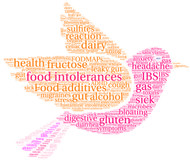Food Intolerances, Allergies and How to Easily Manage it All
Posted by Melanie on 20th Jan 2022

If you suffer from food intolerances or allergies, you know how difficult finding great recipes and shopping for food can be. Some days, it seems like you can’t eat anything. And while food intolerances and allergies are frustrating, they’re not a death sentence. In fact, there are many ways to enjoy your favorite foods and dishes and manage your symptoms at the same time.
In this post, we’ll discuss how to manage food allergies and intolerances, how to identify them in the first place, and how to manage cooking, eating out, and treating yourself.
Let’s dive in.
What Causes Food Allergies and Intolerances?
Food allergies and intolerances crop up when the body can’t process or digest a certain food. In some cases, the allergy or intolerance is due to a lack of digestive enzymes.
In others, it’s a sensitivity to certain chemicals. While there are many thousands of different food allergies or intolerances, these are the most common culprits:
- Milk
- Gluten
- Sulfites
- Caffeine
- Fructose
- Food preservatives and colorings
While the terms “food allergy” and “food intolerance” are often used interchangeably, they have different causes.
Food Allergies
Food allergies are immune system responses. They’re caused when the body mistakes a certain kind of food (typically a protein) as harmful and initiates a defensive immune response to fight it. The most common food allergies include peanuts, milk, eggs, nuts, fish, and shellfish.
Food Intolerances
Food intolerances are digestive system responses. They occur when a certain food irritates a person’s digestive system, or when someone cannot properly digest or process a certain food. Milk is one of the most common culprits for food intolerances.
How to Identify Food Allergies or Intolerances
Today, food allergies affect about one in ten adults and one in thirteen children. Food intolerances, on the other hand, are much more common. For example, about 10% of Americans are lactose intolerant.
If you have a food allergy, you’ll probably notice it right away. Many of the symptoms of food intolerances and allergies are dramatic and uncomfortable. Depending on the severity of your allergy, you may experience nausea, vomiting, stomach pain, diarrhea, heartburn, or cramping. In some cases, however, the symptoms of food allergies can be sneaky.
Weight gain, bloating, breakouts, irritability, and nervousness are all lesser-known signs of food allergies. Because the symptoms vary so widely, the best way to figure out if you have a true food allergy is to get an allergy test from an allergist.
Food allergy testing may take the form of a skin prick or blood test, which will narrow down the exact types of food you’re allergic to.
Alternatively, the allergist may recommend an elimination diet, which is used to identify the specific foods and food groups that are causing you a problem. During an elimination diet, you’ll eliminate all suspected problem foods from your diet, and then begin to add them back in one at a time, keeping an eye out for any adverse reactions.
5 Tips for Coping with Food Allergies or Intolerances
If you have a food allergy or intolerance, it doesn’t mean you have to suffer from uncomfortable symptoms or limited eating forever. Follow these tips to cope with your allergy or intolerance
1. Get good at reading food labels

If you have a food allergy or intolerance, you’ll have to become a part-time detective when it comes to food labels. The reason is simple:
Many consumers misunderstand food labels about allergen exposure, and language like “manufactured on shared equipment” or “may contain” can be confusing. If you have a severe food allergy or intolerance, you’ll want to stay away from food with these labels.
To help you as you navigate the grocery store, there are certain apps that can help you analyze a product's ingredients for your dietary restrictions. One example is Fig, which you can use to scan and search for products to find products that you can have! It's 100% free and available on both iOS and Android in the US.
If you’re tired of reading labels each time you go shopping, learn which brands specialize in allergy-free products and start buying from them. A few brands and outlets we recommend include the following:
2. Make your kitchen (or restaurant order) allergen-free
If everyone in your household isn’t on an allergen-free diet, you’ll need to take care to avoid cross-contamination, especially if your food allergy or intolerance is very severe.
You might consider keeping two sets of cooking and eating utensils, or at least washing all dishes and utensils in hot, soapy water between uses. While this may seem like a pain, it’s one of the best ways to avoid uncomfortable reactions.
If you’re eating out, you’ll have to get smart about what and how you order. There are dozens of delicious, allergy-friendly restaurants that specialize in gluten-free, wheat-free, dairy-free foods and don’t ever introduce allergens into their cooking spaces.
If your intolerance or allergy is mild, you can likely still eat at a normal restaurant if you make the server aware of your dietary restrictions.
3. Change your habits
If you’ve just learned you have a food allergy or intolerance, changing your daily habits can feel like a big task. Mindset is key here.
When you view this as an adventure to better health, rather than something you MUST do, you’ll be better able to manage your symptoms and keep yourself healthy. We recommend linking habit changes with something positive.
For example, if you’ve recently discovered a sugar allergy and you need to cut sugar out of your diet, start treating yourself to a sugar-free treat (like a coffee drink made with our delicious, keto-friendly, diabetes-friendly drink mixes) every afternoon. Not only does this help you change your habits (avoiding sugar consumption throughout the day), but it makes making better choices easy and enjoyable.
4. Get creative with new recipes
If you’ve discovered a food allergy or intolerance, you’ll probably have to change the way you cook. Again, mindset is key. Instead of mourning the old dishes you can no longer eat, find fun new ways to create them.
Pick up a few allergy-friendly cookbooks (we love options like Thug Kitchen, Half Baked Harvest, and Shut Up and Cook!. Experiment to find a few cookbooks that offer easy, allergy-friendly substitutions, delicious recipes, and fun cooking experiences. Yummly is also one of the best recipe apps for people with dietary restrictions!
5. Find joy in the process
When you have a food allergy, taking care of your body becomes your top priority. While this may mean you can no longer do some of the things you once did, it also means you’re exploring a new avenue of your health.
We encourage you to find joy in the process. Be proud of yourself for giving your body what it needs, honoring its messages, and being willing to change your habits.
Make friends with people who share similar allergies, and explore new ways of cooking, eating, and interacting with the world. The process of adapting to your food allergy could be transformative if you let it.
5 Sparrows is Here to Support You on Your Allergy-Free Journey
We’ve left the best news for last: just because you’ve got a food allergy or intolerance does NOT mean you have to forgo all the sweet things in life.
At 5 Sparrows, we make delicious, sugar-free coffee creamers and drink mixes that are suitable for diabetics, people on the Keto or FODMAP diet, gluten-free eaters, and more. Our delicious allergy-friendly drink mixes make each day a little sweeter and are the perfect way to reward yourself for making big changes.
Check out our selection now to find the perfect mix for you.

